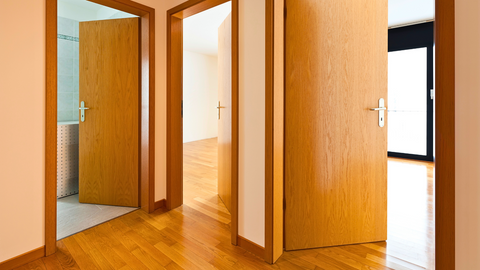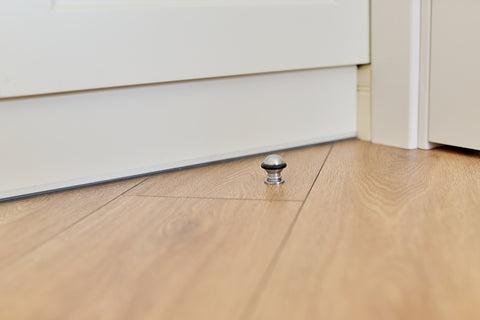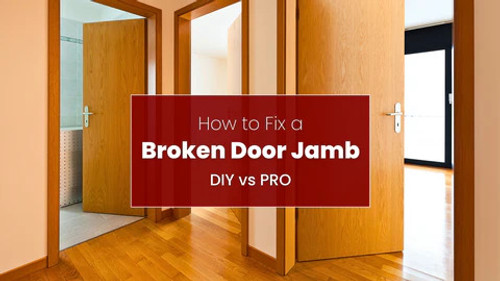How to Fix a Broken Door Jamb: DIY VS Pro Repair
Posted by Door Armor on Jul 1st 2025
Uh oh! Did you just discover a crack on your door jamb after a forced entry attempt? Or maybe a warped frame makes your door difficult to lock. And you have a feeling your door jamb is compromised. Indeed, a broken or cracked door jamb is a major security concern and needs to be fixed immediately. Door jambs are the vertical frames surrounding your doorways which play a crucial role in your home security. They provide structural support for the door itself, ensure proper alignment for latching, and contribute to the overall strength of your entryway.
To fix a broken door jamb, you can either repair it or replace it with a new one. The good news? Not all door jamb damage requires a major home repair project. Depending on the severity and type of damage, you might be able to take care of some repairs yourself. However, in cases of security breaches or significant structural weakness, seeking professional help might be the only option to maintain a secure barrier against intruders.
This blog post will show you how to fix a broken door jamb, from assessing the situation and determining the best course of action–DIY repair, professional repair, or even door reinforcement. We'll also look at some of the preventative measures to keep your door jambs strong and secure.

Assessing the Damage: Conduct A Security Audit for Your Door Jamb
Before repairing a broken door jamb, carry out a thorough security audit of your door jamb. Here's a simple three-step process to assess the damage and its impact on your home security:
1. Identify the Cause
Find out what caused the damage. Knowing the cause of the damage can help you understand the potential security vulnerabilities and determine the best repair approach. Here are some common causes:
- Forced Entry
This could be kicking, prying, or tampering with the locking mechanism. It typically results in cracks, chips, or even broken pieces of the jamb material.
- Impact Damage
This could be an accidental kick or slamming the door too hard. It might cause minor damage, but repeated impacts can weaken the jamb over time.
- Moisture Damage
This often manifests as warping, especially in wooden door jambs exposed to excessive moisture or humidity. A warped door jamb is not a direct security threat, but it can cause door misalignment, affect the latching and hinder proper closure.
- Normal Wear and Tear
Over time, door jambs can experience minor cracks, loose screws, or even paint chipping due to regular use. Wear and tear might not be a major security concern initially, but they can weaken the door jamb over time if unattended.
2. Evaluate the Severity of the Damage
The severity of the damage determines if a DIY repair is what you need or a pro. Here's a breakdown categorized by security risk:
- Minor Damage
Minor damages on the door jamb such as small cracks, superficial scratches, or slightly loose screws should be monitored for further wear and tear.
- Moderate Damage
Moderate Damage includes larger cracks, gouges, or moderate warping. Moderate Damage weakens the overall structure and might require reinforcement or professional repair.
- Severe Damage
Severe Damage involves completely broken jamb sections, significant warping that affects door function, or structural concerns about the surrounding wall. This represents a major security vulnerability and requires immediate attention from a professional carpenter or handyman.
3. Conduct a Security Test
Ask the following questions:
- Can the door be easily forced open, even with minor damage?
- Does the latch mechanism seem loose or compromised?
- Are there any gaps around the door frame that could allow someone to pry open the door?
If the answer to any of these questions is "yes," consider the damaged door jamb a security risk and seek professional repair or door reinforcement solutions.
DIY Solutions for Minor Door Jamb Damage
Now that you've assessed the damage with a security lens, let's look at some DIY solutions for minor door jamb repairs. Remember, these fixes are suitable for small cracks, superficial scratches, or loose screws. For anything that compromises the security of your entryway, calling a professional carpenter or contractor is recommended.

Wood Door Jamb Repair
Small Cracks
For small cracks, you can use tools and materials such as Wood glue, clamps (optional), sandpaper (various grits), paint and paintbrush (optional, for cosmetic touch-up) to fix the crack on the door jamb.
How to fix it
Apply wood glue generously into the crack and use clamps (if needed) to ensure a tight fit. Allow the glue to dry completely according to the manufacturer's instructions. Once dry, sand the area smooth. You can then choose to repaint the repaired area to match the existing door color.
Security Check
After completing the repair, perform another security check. Ensure the crack is fully secured and doesn't compromise the structural integrity of the jamb. If the crack is near the latching mechanism or hinge points, consider seeking professional reinforcement despite a seemingly successful repair.
Steel Door Jamb Repair
Steel door jamb repairs are best left to professionals due to the specialized skills and equipment required. However, for very minor cracks, some suggest patching with sheet metal. This is an advanced repair and should only be attempted by those with metalworking experience and proper safety gear. Even then, security is paramount. For anything more than hairline cracks, consider professional repair or replacement of the steel jamb section.
When to Call a Pro
While DIY repairs can address minor cosmetic issues, there are situations where professional help is needed to ensure the security of your home. Here are some signs it's time to call a professional:
- Forced Entry Damage
Any damage resulting from a break-in attempt requires professional assessment. The compromised jamb might be just the tip of the iceberg, and a thorough inspection is necessary to identify and address any other security vulnerabilities created by the intruder.
- Extensive Damage
If you notice cracks that compromise the structural integrity of the jamb, a significant warping that affects door alignment and latching, or broken jamb sections, you need to choose a professional repair option. A skilled carpenter or handyman can assess the damage, recommend the most appropriate repair approach, and ensure your door functions securely again.
Even if the damage seems minor, if your security test reveals any weaknesses (loose latch, gaps around the door frame), seek professional help. A professional can recommend solutions like door jamb reinforcement kits or even suggest a complete door replacement if the existing one is significantly compromised.
Preventative Measures for Strong Door Jambs
Preventing door jamb damage goes a long way in maintaining a secure home. A strong door jamb improves your home security. Here are some simple yet effective preventative measures:
- Install Door Stoppers: Door stoppers prevent the door from slamming shut with excessive force, and minimize the impact damage to the jamb.

- Use Weather Stripping: Proper weather stripping around the door frame helps prevent moisture infiltration, which can lead to warping, especially for wooden door jambs.
- Maintain Proper Ventilation: In areas prone to moisture buildup (bathrooms, laundry rooms), ensure adequate ventilation to reduce humidity levels and prevent warping.
- Regular Door Maintenance: Inspect your door jambs regularly for any signs of damage, loose screws, or developing cracks. Promptly addressing minor issues can prevent them from escalating into security concerns.
Your door jamb is one of the weakest parts of the door and plays a vital role in your home security. Carrying regular door maintenance and other home improvement projects can help you improve the security of your home.




